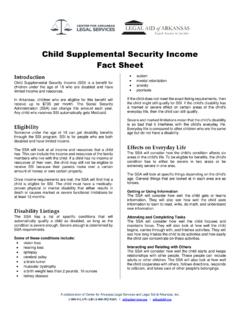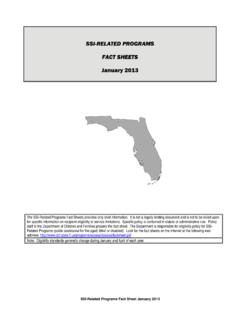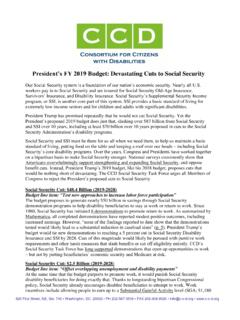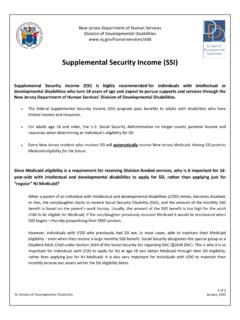Transcription of Fact Sheet on Chained CPI and Social Security
1 fact Sheet on Chained CPI and Social Security fact #1: Social Security Should Not be Part of Deficit/Budget Discussions Social Security solvency issues should be considered on their own. Social Security , with its current $ trillion surplus, does not contribute to the current deficit. We do need to address solvency issues but that should be put on a separate track and considered in a separate legislative vehicle. Social Security should not be changed to reduce the deficit but to address long-term solvency needs. The 1983 Social Security Amendments are still being implemented the age of retirement is rising. Combined with rising Medicare costs, the average worker's take- home Social Security benefit at age 65 is projected to fall to 32% of prior earnings in 2030 (compared to 39% in 2005). (National Academy of Social Insurance: Social Security Benefits, Finances, and Policy Options: A Primer).
2 Instead of further reducing benefits, proposals such as lifting or eliminating the cap on wages subject to FICA taxes ($113,700 in 2013) should be considered instead. fact #2: Chained CPI is not a more accurate measure for seniors The Social Security cost-of-living adjustment (COLA) is designed to protect the purchasing power of Social Security benefits, preventing older Americans and those disabled at young ages from falling into poverty. The CPI-W is currently used to calculate cost-of-living adjustments. It is consistently lower than the CPI for the Elderly (CPI-E) formula an experimental formula first launched in 1988 that many experts say more realistically reflects the purchasing patterns of seniors (and which many experts say has been analyzed sufficiently and should no longer be considered experimental). The CPI-E recognizes that basic cost-of-living expenses for seniors tend to rise faster than the traditional CPI.
3 (National Academy of Social Insurance Social Security fact Sheet : Should Social Security 's Cost-of-Living Adjustment Be Changed?). The Chained CPI formula would result in cost-of-living adjustments even lower than CPI- W. The Chained CPI incorporates changes to reflect substitution patterns across dissimilar categories of items that are simply not realistic for seniors. Seniors spend a higher percentage of their budgets on necessities for which there simply aren't substitutes particularly health care which represents 2-3 times more of their budget. They do not have the same flexibility as younger households to respond to price changes to substitute purchases across categories of consumer goods. From 1983 to 2011, the CPI-W was lower than the CPI-E by more than percentage points per year. Using the Chained CPI would reduce benefits by an additional percentage points per year.
4 According to 250 economists and over 50 Social insurance experts, there is no empirical basis for reducing the Social Security COLA, which could exacerbate, rather than correct, an existing problem. (Economic Policy Institute: Economist and Social insurance expert statement on Social Security COLA). fact #3: Chained CPI is a benefit cut that Social Security beneficiaries cannot afford Social Security benefits are already modest. The average monthly retiree benefit is just $1,262 -- $15,144 a year and about $2,000 less for women. (The benefit is even lower for disabled workers, spouses, and children who would also be affected by the Chained CPI). Two out of three retirees rely on Social Security benefits for a majority of their income, 1 in 3 for 90% or more. Many of them run out of their earned benefits before the end of the month so even a small cut would be devastating.
5 Chained CPI cuts are cumulative the longer you live, the bigger the cuts. Those bigger cuts would come at the same time that savings are depleted and health care and long-term care costs increase. Those most impacted are those who live the longest and people who become disabled at an early age. Chained CPI reduces the value of Social Security benefits by each year on average. By age 70, monthly benefits would be lower, by age 80 lower, and by age 95. lower. Average seniors who retire at age 65 would face a $650 per year benefit cut by age 75, a $1,000 when they turn 85. The Chained CPI would cut a full month's income for a 92. year old. The cumulative impacts are significant. The average lifetime earner would face an $8,100 cut in benefits by age 80, $19,245 by age 90 and $24,976 by age 95. An individual who begins receiving disability benefits at age 35 would receive a benefit that is lower by age 65.
6 The Chained CPI would fall disproportionately on middle-income and low-income Americans. Hardest hit would be those with incomes between $10,000 and $20,000. (Ways and Means Committee Democrats fact Sheet : Impact of Shifting to a Chained CPI). Cuts in Social Security benefits would be a double whammy if coupled with increases in Medicare premiums and out-of-pocket costs. fact #4: Chained CPI hits current beneficiaries The Chained CPI would affect all Social Security beneficiaries including those who are currently receiving their earned benefits. The benefit reductions from the Chained CPI must also be considered in the context of proposals to increase Medicare premiums, which come directly out of Social Security benefits. From 1980 to 2010, the percentage of the average Social Security benefit that is spent on Medicare premium and out-of-pocket costs has risen from 7% to 26%.
7 If a larger share of a smaller Social Security benefit is required to pay for higher Part B and Part D premiums, current and future retirees will be left with even less income to meet other basic necessities. (Chart from Kaiser Family Foundation's Policy Options to Sustain Medicare for the Future). fact #5: Chained CPI is particularly harmful to women Women rely on Social Security for a larger share of their retirement income for 38% of women age 80 and older, it represents 90% or more of their total income. It is 100% of income for 23% of older women. Women live longer than men the cumulative impacts of the Chained CPI would be especially harmful for them. Women's benefits are lower the median benefit for a single woman age 65 or older is just $1,100 per month ($13,200 a year). The Chained CPI would reduce that benefit by $56 a month at age 80 the equivalent of a week of food a month.
8 By age 95, the loss would be the equivalent of 13 days of food each month. (National Women's Law Center Social Security fact Sheet : Switching to the Chained CPI Means Painful Cuts to Social Security Benefits Especially for Women). While some proposals recognize the harmful impacts to women by including a benefit bump-up, those proposals provide little relief because they require Social Security recipients to wait 20 years or more before they get a higher, temporary benefit. (National Women's Law Center Social Security fact Sheet : Chained CPI Imposes Painful Social Security Benefit Cuts and a Benefit Bump-Up Provides Only Limited Relief). fact #6: Chained CPI affects more than Social Security including veterans benefits Veterans are hit twice by the Chained CPI. Over 9 million veterans 1 in 4 receive Social Security benefits. According to the Social Security Administration, more than 1.
9 Out of 5 adult Social Security beneficiaries have served in the military, and veterans and their families comprise 35 percent of the beneficiary population. The average retirement benefit was about $15,500 in 2010. Adopting the Chained CPI would reduce the Social Security earned benefit for a veteran with average earnings by $600 at age 75 and $1,000. by age 85. In addition, the Chained CPI would cut benefits for more than million disabled veterans. Permanently disabled veterans receiving VA disability benefits beginning at age 30 would face a benefit cut of $1,400 a year at age 45, $2,300 a year at age 55 and $3,200 a year at age 65. Veterans groups like the American Legion, Paralyzed Veterans of American, VFW, Gold Star Wives and Vietnam Veterans of America all oppose the Chained CPI. (Joint Letter from Assorted Veterans Groups Opposing Chained CPI, American Legion Letter Opposing Chained CPI).
10 fact #7: Chained CPI is not necessary. We can solve Social Security 's 75-year solvency gap but this should be done outside of budget and deficit negotiations. Solutions should focus on raising revenues not cutting benefits that extremely modest. The public strongly supports that approach. According to a recent survey for the National Academy of Social Insurance, 84% believe that Social Security benefits to not provide enough income for retirees. Over 70% support a package that would increase the COLA to reflect the level of inflation faced by seniors, raise the basic minimum benefit, eliminate the cap on earnings subject to FICA taxation, and gradually raise the tax rate from to (National Academy of Social Insurance: Strengthening Social Security : What Do Americans Want?).









